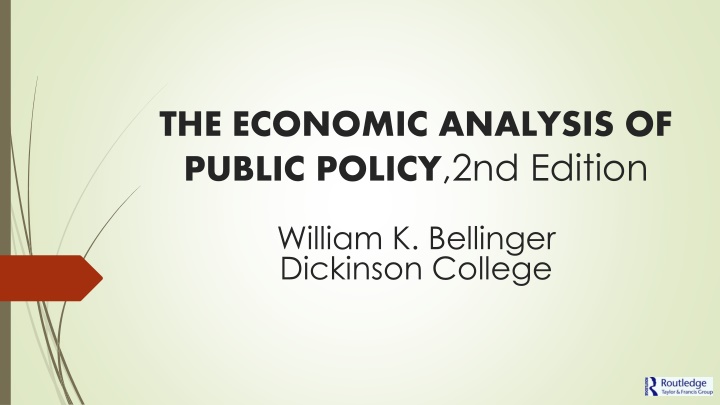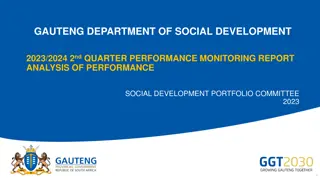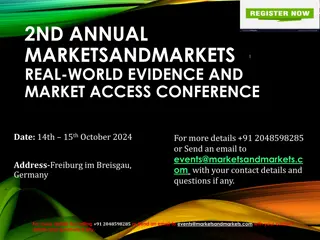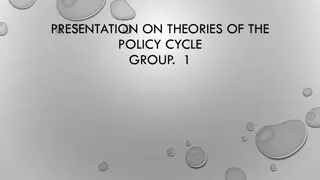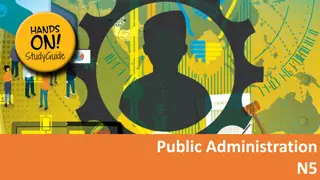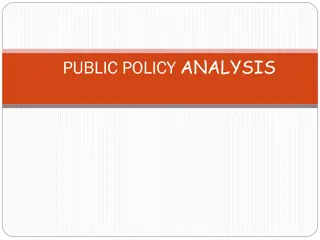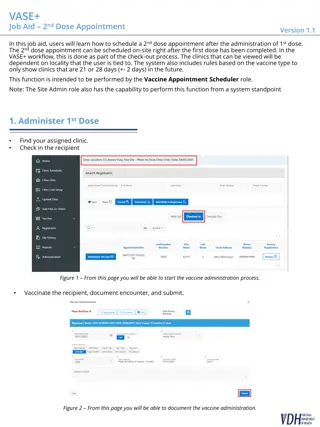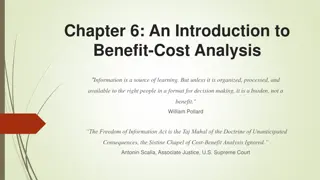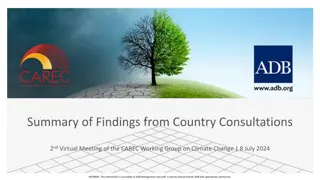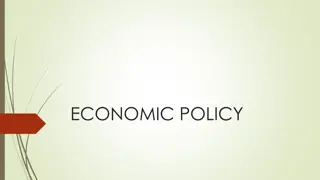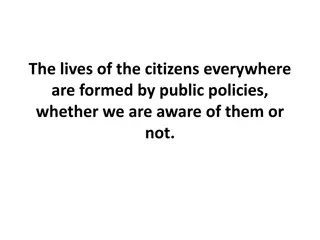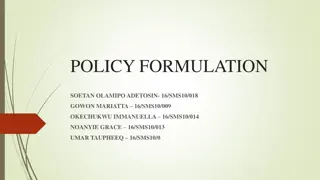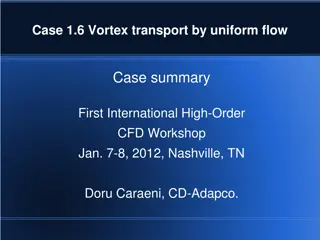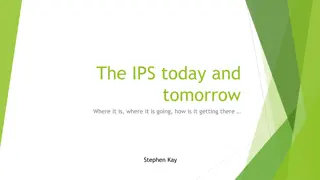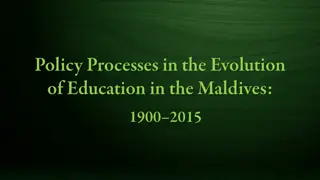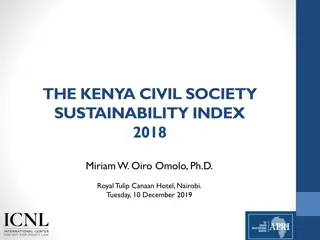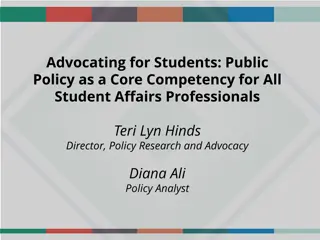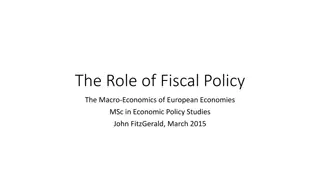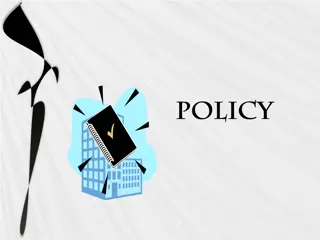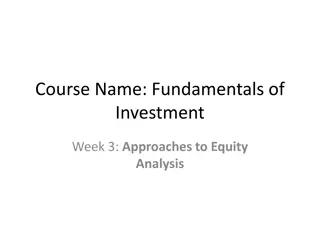Economic Analysis of Public Policy, 2nd Edition Summary
This content provides a detailed overview of the concepts and tools for policy analysis from "The Economic Analysis of Public Policy, 2nd Edition" by William K. Bellinger. It covers key chapters such as the meaning of policy analysis, ethical goals for public policy, and the benefits and costs of decision-making. The text emphasizes critical thinking, ethical considerations, and rational decision-making processes in evaluating policies. It also includes a practical exercise on weighing the benefits and costs of attending college versus getting a job.
Download Presentation

Please find below an Image/Link to download the presentation.
The content on the website is provided AS IS for your information and personal use only. It may not be sold, licensed, or shared on other websites without obtaining consent from the author.If you encounter any issues during the download, it is possible that the publisher has removed the file from their server.
You are allowed to download the files provided on this website for personal or commercial use, subject to the condition that they are used lawfully. All files are the property of their respective owners.
The content on the website is provided AS IS for your information and personal use only. It may not be sold, licensed, or shared on other websites without obtaining consent from the author.
E N D
Presentation Transcript
THE ECONOMIC ANALYSIS OF PUBLIC POLICY,2nd Edition William K. Bellinger Dickinson College
Section I: Concepts and Tools for Policy Analysis The first chapter of the book introduces the reader to the basic meaning of policy analysis and its various uses in the political process. The chapter also discusses the process of critical thinking about the arguments and evidence presented in policy research and political discussion. Chapter 2 begins with a basic overview of the competitive market. It then introduces the net benefits of market exchange to consumers and producers. The model of the utility maximizing consumer is then introduced and related to a set of policy examples. The third chapter introduces the reader to a set of basic ethical goals for public policy, as well as three theories of distributional justice that can be productively applied to some applications of policy analysis. Those who wish to get right to the applied economic analysis might be tempted to skip this section. In my view the costs of that choice will ultimately outweigh its benefits.
Chapter 1: The Meaning of Policy Analysis "Do not believe in anything simply because you have heard it. Do not believe in anything simply because it is spoken and rumored by many. Do not believe in anything simply because it is found written in your religious books. Do not believe in anything merely on the authority of your teachers and elders. Do not believe in traditions because they have been handed down for many generations. But after observation and analysis, when you find that anything agrees with reason and is conducive to the good and benefit of one and all, then accept it and live up to it." Gautama Siddharta, the Buddha
Introduction my way is to divide half a sheet of paper by a line into two columns; writing over the one Pro and over the other Con If thus proceeding I find... where the balance lies I come to a determination accordingly . I have found great advantage from this kind of equation, in what may be called moral or prudential algebra. Benjamin Franklin At the most general level, efforts to weigh the benefits and costs of a public or private decision involve some version of the economic analysis presented in this book. At a basic level, this decision process can take the form of a list of pluses and minuses, as in the quote from Benjamin Franklin, or a list of factors favoring one choice over another. At a more advanced level, this rational decision process can include efforts to measure all relevant benefits and costs using a common scale such as dollars in order to determine course of action that maximizes the difference between the total benefits and costs of the choice.
Your Turn 1-1: The Benefits and Costs of a College Education Your Turn 1-1: Create a list of the benefits and costs of attending college versus getting a job. Include benefits that will occur in the future as well as the present, effects on others and on society as a whole as well as yourselves, and non-monetary as well as financial benefits and costs. After making some judgment about which benefits and costs are most important, do your expected benefits outweigh your costs? Do the benefits to others, including your parents and your government, of your college education outweigh their costs? Perhaps the questions raised by this exercise are more important than any judgment.
Some Policy Analysis Questions (1) Are the total benefits of this policy choice greater than the total costs? (2) Does this policy offer greater net benefits (total benefits total costs) than another alternative? (3) How large a budget is required for this policy? A detailed benefit-cost analysis of policy alternatives can help one to answer such questions.
Non-Marketed Benefits and Costs Benefit-cost analysis attempts to estimate dollar values for all benefits and costs, even when the good in question is never actually bought or sold. For example, the benefits of a new section of highway include time savings for travelers due to the lessening of congestion. Costs include construction spending, the loss of the benefits of alternative projects, added noise, increased danger from higher speeds, and an increase in road kill . Policy analysis often relies on estimated dollar values for judging benefits and costs even when market prices are not available.
Efficiency According to economic theory, a society achieves allocative efficiency if it provides the greatest possible level of well-being for society given a limited set of resources. At the level of individual policy, efficiency is generally translated into maximizing the difference between the total benefits and total costs of that policy. While the economic theory of efficiency is well established, applying efficiency concepts to policy issues often involves significant challenges when defining and measuring benefits and costs. Also, the goal of efficiency may conflict with other policy goals such as equity or fairness, producing legitimate debate among those on different sides of the issue.
Equity As a goal of public policy, equity generally involves the pursuit of one or more broad goals such as income equality, minimum standards of treatment, or freedom. As with efficiency, determining a policy s ability to meet equity goals can be difficult, and conflict between ethical and other policy goals presents a frequent challenge for policy makers. Furthermore, there are many ethical theories with conflicting conclusions and policy prescriptions. The lack of an accepted ethical paradigm for policy analysis tends to lessen the practical importance of ethical theory, yet the view of this book is that ethical goals provide an important basis for weighing the legitimacy of competing policy proposals.
Political Practicality A policy will be politically practical if it has sufficient support to be passed into law and practice by the legislative and administrative branches of government. Political practicality also involves meeting the broader rules and norms of government, such as the United States Constitution or British Common Law, in order to survive a possible judicial review. In addition to passing constitutional review by the courts, a successful policy must achieve popular and legislative support in order to pass into the legal code, and must then be effectively administered or enforced in order to have a significant effect on the public.
Steps in Policy Analysis, U.S. Office of Management and Budget (1) State the policy rationale, or the goal of the policy, (2) explicitly state the assumptions used in the analysis, (3) evaluate alternatives, including different program sizes, program methods, and public sector involvement, (4) identify and measure benefits and costs, and (5) verify results through follow-up studies.
Steps in Policy Analysis: Eugene Bardach (1) define the problem, (2) assemble evidence, (3) select criteria for making the decision, (4) construct alternatives, (5) predict the outcome of each alternative, (6) confront the tradeoffs, (7) make recommendations, and (8) tell your story.
Comparing the Two Visions of the Policy Process These two lists of steps overlap in several ways. For example, stating a policy rationale generally requires one to identify the problem being addressed and how the policy will reduce or eliminate that problem. Explicitly stating one s assumptions is part of defining the problem and the criteria for judging alternative solutions. The primary difference in the two lists is that the OMB procedures do not include policy recommendations.
Views of Government and the Roles of the Policy Analyst
The Progressive Neutral Expert Nelson s first role for the policy analyst is the progressive neutral expert (Nelson, p. 52). This role is based on the progressive era s view that the administration of government should be above corrupting interests and based on sound management principles (see Wilson, 1941 reprint). The progressive era extends from the late 19th century to roughly World War I. In this vision of government, the rational analysis of policy has a powerful role in determining government s course of action.
The Entrepreneur for Efficiency Robert Nelson s second role for the policy economist is labeled the entrepreneur for efficiency (p. 54). The entrepreneur for efficiency conducts policy analysis and also actively promotes economics or efficiency-based policy designs. This more active role for the analyst is based on a newer theory of government behavior that was developed in the 1950s. This view sees government, and particularly the legislative process, as a struggle among competing groups promoting their own self-interest (Truman).
The Ideological Combatant Nelson s third role for the government economist is the ideological combatant . This role is based on the idea that ideology as well as self-interest guide policymakers, and that the battle of ideas may be as important as the battle of interests in determining public policy.
Advocacy and Analysis In the context of competing interests and ideals, conflict often exists between relatively objective analysis and political advocacy. An advocate is one who pleads the cause of another or supports any cause by argument (Webster). In the case of public policy, advocacy involves the support of a specific policy goal or point of view, and the political advocate also tends to act by building a case for one side of even the most debatable policy proposals. Advocates for a particular viewpoint on a debatable are likely to be biased in a number of ways, and being able to identify these sources of bias is crucial if a student is going to be able to think critically and objectively about policy.
Interdisciplinary Analysis An effective policy analyst must be able to trade ideas with engineers, other social scientists, scientists, lawyers, government officials, and the general public. For example, the analysis of highways or mass transit systems requires input from transportation engineers, while the analysis of crime policy may require input from criminologists with backgrounds in sociology or other social sciences, as well as experts in law enforcement. Informed discussions of environmental policy require information from biological, chemical, geological or environmental scientists. In addition, communication with public administrators, elected officials, and other interested parties is essential to the effectiveness of policy analysis, in part because one or more of these groups is probably sponsoring the analysis, and also because they have an active role in implementing legislation or regulations related to the policy in question.
Analytical Models Analytical models provide the crucial definitions and logic that are part of most well-constructed arguments. These models may be based on social science, physical or biological science, legal scholarship, moral philosophy, or other academic fields. Any analytical model will contain the following components; (1) initial assumptions and value judgments, (2) definitions of terms, (3) causal relationships, and (4) logical conclusions. Models usually are judged on their ability to explain, predict, or productively guide human actions. In the social sciences the conclusions of theoretical models take the form of predictions about human behavior or the effects of policy alternatives.
Assumptions Assumptions are stated or unstated value judgments, definitions, and interpretations of fact that are usually made without supporting evidence. The role of assumptions in an analytical model is to simplify and focus the analysis. For example, economists often assume that markets are competitive and efficient unless otherwise noted. Similarly, Marxists assume a set of social relations between classes that include elements of oppression and exploitation of the working class. Finally analysis based on race, class, gender, or other categories of the population implicitly assumes that members of a given group are similar enough to be analyzed without explicit reference to individual differences.
Types of Evidence: Case Studies A case study involves a detailed evaluation of an individual person, firm, industry, or geographic area. Case studies are deliberately limited in scope in order to emphasize detailed information. The primary weakness of the case study is its inability to answer a few fundamental questions about a policy problem. Most obviously, case studies are inherently incapable of identifying how frequently a problem occurs. The broader causes and effects of a policy problem, such as total costs or global impacts, cannot be addressed thoroughly through case studies. Also, the subjects of case studies might be chosen in a biased manner and therefore may be misleading or unrepresentative.
Types of Evidence: Expert Opinion Expertise is usually measured by one s academic degrees, publication record, and experience. However, an expert s opinions can be subject to the same ideological bias as those of a common citizen or politician, and can be analyzed using the same types of questions. For example, is an expert s conclusion typical of research in that area? Is her argument fully supported by logic and evidence, or is it weak in one or both respects? Such questions help guide one s critical thinking about any issue. When one considers a literature review of a policy topic, he or she should pay attention to the range of results in addition to the typical median estimate.
Types of Evidence: Official Statistics Statistics from government agencies and other public and private organizations provide another prime source of evidence for public policy analysis and debate. Their primary strength is their ability to identify the frequency or breadth of a problem based on large samples of the population. The controversies surrounding government statistics are more likely to be based on their definitions or their use by advocates more often than their measurement accuracy.
An example: Unemployment A person is considered unemployed if she is not currently working for pay but is actively seeking employment. Similarly, a person is counted as in the labor force if he is either working at least one hour per week for pay or in a family business, or is actively looking for work. In other words, the labor force is made up of two groups, the employed and the unemployed. Your Turn 1-2: Based on the previous paragraph, answer the following questions: (1) If a lawyer is currently working as a cashier at K-Mart, is she counted as unemployed? (2) Is someone who wants to work full-time but only works one hour per week unemployed? (3) Is a full time student who is not currently working for pay unemployed? (4) Are you currently unemployed? Individuals who are not actively looking for work but would take a job if offered are called either marginally attached workers or discouraged workers, depending on their reason for not actively searching for work, and are now measured separately by the U.S. Bureau of Labor Statistics.
The Presentation of Statistics One might discuss unemployment, poverty, profits, or virtually any statistic as a total number or as a percentage of some larger sum. Your Turn 1-3: Consider these statements based on the 2014 Congressional Budget Office report on a proposed minimum wage increase to $10.10 per hour: A) Raising the minimum wage from $7.25 to $10.10 will decrease employment by 500,000 jobs. (B) Raising the minimum wage by one dollar will decrease U.S. employment by only one third of one percent. Which piece of evidence sounds more reasonable to you? Why? Beware the big number. In a large economy billions of Euros or thousands of people do not always represent socially significant sums.
Correlation does not Prove Causation Another common fallacy in the use of evidence is to assume that when two events are correlated, one event caused the other. This is referred to as post-hoc, propter-hoc analysis, or false cause reasoning. Proving a cause and effect relationship requires a combination of theory and evidence, and cannot be accomplished through a statistical correlation alone. A less than scientific model of stock prices is the Super Bowl theory, which predicts that a victory by the U.S. football s National Football Conference leads to rising stock prices. As of 2014 this theory has been correct 33 out of 41 times. This is not taken seriously by anybody, but it does provide an example of false cause reasoning.
Critical Thinking about Policy Analysis Three common critiques of benefit-cost analysis relate to the utilitarian philosophy that underlies the benefit-cost model, the appropriateness of assigning dollar values to non-marketed goods, and objections to the microeconomic foundations of benefit-cost analysis. Institutional and radical economists are likely to argue that markets are dominated more by power and oppression than by supply and demand (Dorman). If so, measuring benefits and costs on the basis of market concepts is likely to be misdirected and inaccurate. Another objection to benefit-cost analysis arises from populists, who consider the desires of the people to be the primary basis for policy. According to this view any expert analysis may be considered somewhat anti-democratic.
